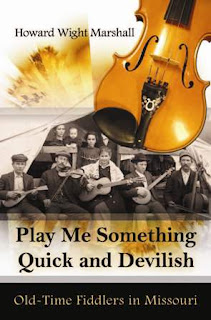To quote the grandparents of every budding angsty teenager, “Kids these days.” This is a classic phrase used by the wiser generation when describing their usual disappointments in the current generation. Kids these days listen to music that has no meaning, does damage to the brain, or influences our view of the world. It was true when Elvis Presley became popular, and it is still true today. Let’s face it, usually the only people that like the music of the current generation are the “youngins” of that generation. It is rare that you would find teens of this time period listening to anything besides what is played on the radio, or what is currently popular among their peers. That being said, I think it’s safe to say it couldn’t hurt to add a bit of Missouri culture to our lives! Let’s put our iPods aside for the moment and introduce something different into our musical repertoire. It’s time to get fit as a fiddle and listen to some “quick and devilish” traditional fiddle music with a man who lives and breathes the art of fiddling, Howard Wight Marshall! --Kimberly Ring , Intern, University of Missouri Press
Play Me Something Quick and Devilish explores the heritage of traditional fiddle music in Missouri. Howard Wight Marshall considers the place of homemade music in people’s lives across social and ethnic communities from the late 1700s to the World War I years and into the early 1920s. This exceptionally important and complex period provided the foundations in history and settlement for the evolution of today’s old-time fiddling.
Beginning with the French villages on the Mississippi River, Marshall leads us chronologically through the settlement of the state and how these communities established our cultural heritage. Other core populations include the “Old Stock Americans” (primarily Scotch-Irish from Kentucky, Tennessee, North Carolina, and Virginia), African Americans, German-speaking immigrants, people with American Indian ancestry (focusing on Cherokee families dating from the Trail of Tears in the 1830s), and Irish railroad workers in the post–Civil War period. These are the primary communities whose fiddle and dance traditions came together on the Missouri frontier to cultivate the bounty of old-time fiddling enjoyed today.
“This phenomenally entertaining and glorious volume should grace the library of every musician and historian. Bravo, Professor Marshall!”
– Mary McWay Seaman, The Celtic Connection
Howard Wight Marshall is Professor Emeritus in the Department of Art History and Archaeology at the University of Missouri, Columbia and former director of the Missouri Cultural Heritage Center. He is the author or editor of ten books, including Barns of Missouri: Storehouses of History. He lives near Fulton, Missouri.
Links to: Audio Interview, Blogs, and Fiddling
In this clip from the 2001 house concert at KOPN, Leroy Canaday plays a great old country rag called "Whistling Rufus," one of his favorites and a tune discussed in Play Me Something Quick and Devilish. Canday's performance style well represents the hard-driving "Little Dixie style" of Missouri fiddling.
Taylor McBaine fiddles one of the first tunes he learned as a child of six or seven, “Climbing the Stairs the Monkey,” an old favorite in Missouri and known by other titles, such as “Moss Billy” and “Shelby’s Mule.” Just as he had learned it as a young beginning fiddler, McBaine favored this tune as a teaching tune when he, in turn, passed the music on to others.
Q: What inspired you to consider writing "Play Me Something Quick and Devilish"?
My inspiration has always been the people, stories, and grassroots history behind the music people make. I learned to appreciate all kinds of music, and admiration of my grandfather Wiley Marshall has always been a driving force behind my interest in “the fiddle”; he was the principal fiddler in our family when I was a child, but there have been fiddlers in the family in central Missouri since the 1830s.
I began playing traditional music as a teenager in the 1960s in the “Folk Music Boom.” (At the same time, I was devoted to modern jazz.) After coming out of the military in 1966, I returned to college in Missouri and soon became dedicated to recording and understanding, as well as performing and listening to, “old-time music.” In grad school at Indiana (Folklore Institute), I concentrated on material culture and folk architecture, and my career took me to museums, the Library of Congress, Kansas State University, and finally to the University of Missouri. My principal pastime through the years, however, has been performing and studying traditional music. This book and CD are the result of a life devoted to traditional music and grassroots culture.
Q: What did you learn from writing this book?
Several aspects of the world of traditional music have barely been scratched by researchers in Missouri. These aspects include such areas as African American fiddlers and their legacy today, the role of fiddlers with Native American ancestry (of which there are many in Missouri), the so-called brass band movement after the Civil War and its relationship to fiddling, musical literacy in the late Victorian Age, the role of immigrant German-speaking music teachers in small towns, and the role of Tin Pan Alley compositions in the traditional fiddlers’ repertoire; these and other seldom-studied subjects are explored in Play Me Something Quick and Devilish.


No comments:
Post a Comment